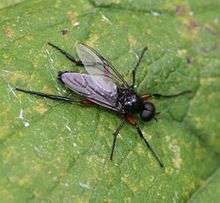Bibio pomonae
Bibio pomonae, common name red-thighed St Mark's fly or heather fly, is a species of fly (Diptera) belonging to the family Bibionidae.
| Bibio pomonae | |
|---|---|
| Bibio pomonae, female | |
 | |
| Bibio pomonae, male | |
| Scientific classification | |
| Kingdom: | |
| Phylum: | |
| Class: | |
| Order: | |
| Family: | |
| Genus: | |
| Species: | B. pomonae |
| Binomial name | |
| Bibio pomonae (Fabricius, 1775)[1] | |
| Synonyms | |
Description
Bibio pomonae can reach a length of about 10–13 millimetres (0.39–0.51 in), while the length of the wings reaches 8–12 millimetres (0.31–0.47 in).[3] The basic body color is shiny black, with a black long abdomen, deep crimson-red femurs and dark tibiae and tarsi. Front tibia show a pair of large spurs. Wings are milky-white with darkened veins on the costal area and a dark spot on the leading edge. The 10-segmented antennae are relatively short and thick. Males and females are very different, as the holoptic males show very large eyes and a flattened abdomen, while the females have small head and eyes and a sharp abdomen.[4] The larvae are reddish brown.
Biology
Adults feed mostly on nectar and are important pollinators.[4] Larvae develop during Fall and Winter feeding on dead leaves, compost, decaying organic matter and Poaceae roots [3][5]
Adults are late summer flyers, but they occur from May to October.[3] [6] In Norway's Hardangarvidda it has been observed that they appear in large numbers every third year, which suggests the larvae take three years to develop.[7]
Distribution
This species can be found across most of the Palearctic ecozone (Europe and North Asia), but in southern Europe can be found only in the mountains.[8]
Habitat
This fly occurs in hedge rows of hill countries, on moorland and mountain birch forests, in woodland edges, fields and in wetlands.[3]
References
- Freeman, Paul; Lane, Richard P. (1985). "Bibionid and Scatopsid flies, Diptera: Bibionidae & Scatopsidae". Handbooks for the identification of British insects. 9 (7). London: Royal Entomological Society of London: 74. Cite journal requires
|journal=(help) - Biolib
- Commanster
- Wildlife Trust
- Triplethorne & Johnson (2004). Borror's Introduction to the Study of Insects, Brooks-Cole. 715-716
- Key to Highland Bibionids
- Borgstrøm, Reidar and Skartveit, John, Russefluga (Bibio pomonae): Eit viktig insekt i høgfjellsøkosystemet, Naturen, p.20-24 DOI: 10.18261/issn.1504-3118-2018-01-04
- Fauna Europaea